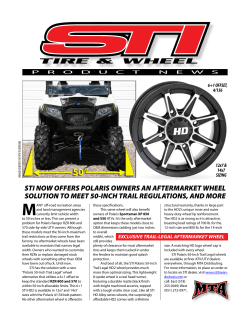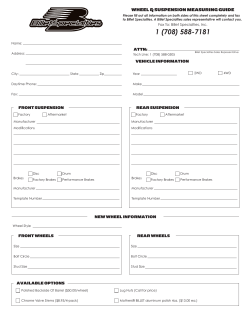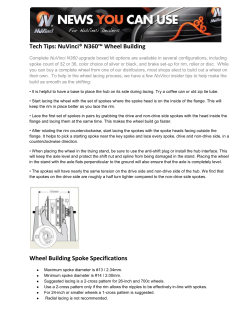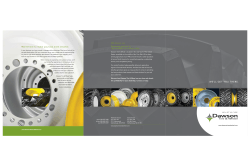
Front wheel alignment on Can-Am Spyders.
Front wheel alignment on Can-Am Spyders. BRP Australia imports Spyders in knocked-down form from the BRP factory, then relies on individual Dealers around the country to assemble them. Most BRP Dealers are motorcycle or jet-ski specialists and do not have wheel-alignment facilities. Few specialist car alignment firms can handle a Spyder, either. Wheel alignment is part of the factory assembly process so Dealers are NOT REQUIRED to do a wheel alignment before selling a new Spyder. They just do a pre-sale assembly from the crate and a safety check but, for some reason, by the time they hit the road in Australia, alignment is wrong, and often by a huge amount. There seem to be two alternatives, and neither of them are acceptable: 1. ...that the Spyder steering geometry is easily knocked out of alignment, and this happens at some stage between factory assembly and Dealer re-assembly. After studying lots of photos of Spyders being uncrated I see no evidence that their crating method is to blame... but that means that it must be either rough handling during shipping or a factory error by BRP – they just don’t do the alignment correctly. 2. ...that the Dealer has performed an alignment. For ALL Dealers, for all types of vehicles, the manufacturer’s Workshop Manual is their ‘Bible’, so you cannot blame a Dealer for sticking to that. But the method described in BRP’s Workshop Manual is inaccurate, very long-winded ( = expensive ), and the instructions simply incorrect, so that Spyders aligned ‘by the book’ have virtually zero toe-in, which becomes toe-out in motion, making them very nervous and twitchy ( although this reason would not explain the huge toe-out found on many brand-new Spyders ). • There is no reason for owners to say things like: “Oh, Spyders always have twitchy, wandering steering and wear tyres out quickly – that’s just normal.” Well, it’s NOT normal, and can be easily fixed to restore good handling. Another common complaint is that the bike pulls very slightly to the left here, or to the right in the USA. This is just the camber of the road – Spyders are much lighter than cars, and have very direct Power Steering with no ‘stiffness’ like a car’s steering, so they don’t keep tracking straight if you let go the bars. For most vehicles, that’s a wheel CAMBER issue – but camber is factory-set on a Spyder, and can’t be changed. Using wheel-alignment to compensate really just changes the handlebar center. Using different front left / right tyre pressures has a better chance of addressing this very small problem. A further important factor is that the suspension is a collection of many ball-joints and bushes, and all of them have a little bit of play. When the suspension is working over bumps or through corners, wheel alignment WILL change momentarily, stretching towards additional toe-OUT, because the Spyder has rearwheel-drive... it is always pushing the mass of the front-end geometry, and this causes the wheels to ‘spread’ in motion. A bike with 0.5mm toe-in at rest will have zero toe-in in motion, given good conditions for all bearings, bushings and ball-joints. This variance will increase with age and wear. Toe-in or Toe-out? Front wheels have CAMBER ( leaning in or out ), CASTER ( raking backward on its vertical axis ) and toein or toe-out ( pigeon-toed or splay-footed ). Camber and Caster is factory-set on a Spyder, but toe-in / out can be adjusted. BRP specifies contradictory figures in the Spyder Workshop Manual. In one place, 0.5– 1.0mm toe-IN over the diameter of the wheel is specified. Elsewhere in the Workshop Manual it is toe-OUT of 0.0–1.00mm with 0.5mm as an optimum. This is most likely a mistake. Toe-OUT leads to tyre-scrubbing and wandering on any vehicle, and toe-IN is known to be used by two commercial Spyder services: • The US Rolo laser system is custom-made for Spyders, and is designed to produce toe-IN of a minuscule 0.2mm over the diameter of the wheel – at the lowest possible end of the BRP specs. To all intents and purposes, that’s ZERO toe-in. Suits a racetrack, where instant turn response and minimum ‘rollingresistance’ is more important than straight-line tracking, but is unsuitable for real-world bumpy roads. • The US Lamonster Garage ( using Rolo laser equipment ) offers a laser alignment service based on 3mm toe-in over the diameter of the wheel. That’s quite a large amount, well outside the BRP specs, much easier to measure, but definitely toe-IN. Suits the US, where straight-line highway driving is the norm. The alignment method described in the Spyder Workshop Manual, using a six-foot straight-edge clamped to the chassis, one side of the bike at a time, leads to a Double-Whammy problem when Dealers use BRP’s inadequate toe-in specs. Even if they use the ‘top-end’ toe-in spec of 1.0mm, the Manual describes how to measure that over the whole 6-foot straight-edge instead of just across-the-wheel, so they end up with acrossthe-wheel toe-in of only 0.2mm. This makes an ‘officially-aligned’ Spyder hard to steer on anything except very smooth surfaces, because that tiny toe-in becomes toe-out in motion. Having proper wheel alignment DOES make a Spyder much easier to ride! Scaling it up: The ‘Alignment Box’ Method. Measuring small distances is very difficult. So the laser is used to describe a ‘box’ about the size of the entire bike, so that the toe-in over this greatly-expanded distance can be measured more accurately. It just happens that the length of a Spyder, from the center of the front wheel to just aft of the rear tyre’s contact patch is 1.9 meters ( close to the six feet specified by BRP ), or exactly 5 times the diameter of the front wheel (15” / 380mm for 2008-2012 models, or 16” / 405mm for 2013- models). That’s a handy 5X magnification factor. Instead of a 1mm, 2mm or 3mm toe-in across-the-wheel, a magnified 5mm, 10mm or 15mm toe-in at the end of the Box is much easier to measure and adjust, using the laser level as a laser pointer rather than just as a straight-edge as the BRP method specifies. It also makes it easy to spot when one wheel is on a different alignment to the other one. It is quite common to find one wheel toed-in while the other is toed-out ( causes tracking or crabbing problems ), or to find both wheels toed-out instead of toed-in (,causes tyre scrubbing and wandering,). Recent tests ( ST models ) have revealed uneven alignment with the right tyre scrubbing, even though the left was more out of alignment. The Alignment Box method allowed this uneven alignment to be detected because each wheel is measured against the whole chassis, not just against the other wheel. Another factor is that we drive on the left, so that the left wheel carries most of the steering load, and it is the relatively unloaded right wheel that scrubs the most. So what’s best? BRP’s almost-zero toe-in works well enough on dead-smooth roads, but tends to dance around erratically over real-world bumpy roads. It is just TOO neutral, too unpredictable, too ‘lively’. A larger toe-in of 1.0mm works better on bumpy roads... but when you get to VERY large toe-in like 10mm or more, this makes handling almost impossible – it ‘ploughs’. Lindsay’s 2008 RS model Spyder previously had zero toe-in, and was extremely nervous and twitchy, but it has standard ( soft ) front suspension, so it was set to 2mm toe-IN. This produced good straight-line tracking – no nervousness as before. It had fairly neutral corner turn-in and tracking, even over rough surfaces or negative camber, with little or no mid-corner ‘bite’, and would be good for touring. After thorough testing, though, it has now been pulled back to 1.5mm toe-in, closer to the more ‘active’ range. Rough or uneven roads are far more common here than billiard-table-smooth roads, so a larger amount of toe-in than recommended by BRP seems the sensible way to go. There are many enthusiastic endorsements of the Lamonster alignment service, using 3mm toe-in ( mostly on RT models ), even though 3mm (,1/8”,) seems excessive. But it’s just the traditional toe-in used on cars for decades. Experiments continue, looking for a toe-in figure that works best under local conditions. BRP’s 0.5mm is simply impractical – forget it! So somewhere between 1mm ( still very lively ) and 3mm (,just short of understeer, suitable for highway cruising ) over-the-wheel is a workable range. Closer to 1mm toe-in for aggressive riding or stiff suspension, or closer to 3mm for cruising or soft suspension. Rider weight and riding style will influence this, since suspension deflection causes momentary toe-out bias... if the toe-in is close to zero, it becomes toe-out momentarily at times. Recommendations: These will change over time as more data is accumulated. • For RS or ST models, about 1.0–2.0mm toe-in, with 1.5mm optimum. Enough to avoid the straight-line nervousness but still suitable for aggressive riding. Use larger toe-in for heavy riders/loads, less for stiffer front suspension. • For RT models, about 1.5–2.5mm toe-in, with 2.0mm optimum. Smooth straight-line tracking for cruising without straying into understeer. Adjust for load as with other models. TWO WHEEL ALIGNMENT SOLUTIONS: Solution #1: If you live in Brisbane, contact Charcol. He has made tripod jigs to fit through the spokes of the front wheels, allowing lasers to be attached directly to the brake discs. This is more accurate than using the wheel rim, which might have a slight buckle or ding. They were built to suit existing laser levels with rotating heads. The tripods have returns on the two top legs that hook behind the brake disc, while the bottom leg rests on the front surface of the disc, and the weight of the jig holds it in place. It sits on the disc exactly parallel, and is accurate to within 0.5mm ( half the laser dot ) at 2m. Charcol made the clip-on jigs this way so that the front wheels do not have to be removed to perform an alignment. The job will take about an hour. Solution #2: Do your own alignment. Few people, however, can accurately manufacture jigs like this, so DIY alignments demand a different method. Still using the ‘Alignment Box’ system, but using cheap, small magnetic-base laser levels in a wheels-on procedure using stand-off jigs that are within the skills of the average DIY-er. A separate page sets out a step-by-step DIY alignment method. View that file here: http://www.lindsayroland.com/pdf/Spyder-DIY-Alignment.pdf Apart from alignments performed on Charcoal’s 2008 GS model or Lindsay’s 2008 RS model, several RT and ST models have since also been aligned using Charcol’s rig, with astonishingly-large toe-OUT being corrected to restore proper handling to suit the owner’s needs. 2013models, especially, are quite different to earlier models, with extra difficulties in adjusting tie-rods ( left side only ). This document prepared by Lindsay Whipp in collaboration with Colin Crutchley. Contact either of them on the www.ozspyderryders.com or www.spydermates.com forums under their respective Usernames: Charcol and Lindsayw – or contact Lindsay via his personal website at www.lindsayroland.com or the attached Bickie-Gang forum. Charcol will accept inquiries from owners in the Brisbane area on an all-care but no-responsibility basis, as he is not a licensed auto-mechanic.
© Copyright 2025











